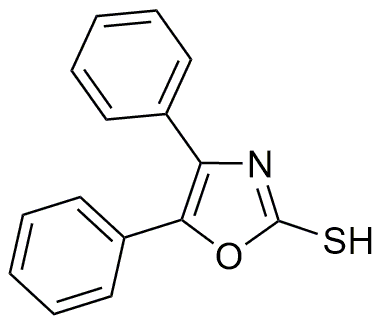4,5-Diphenyl-2-oxazolethiol is widely utilized in research focused on:
- Analytical Chemistry: This compound serves as a reagent for the detection of metal ions, particularly in environmental samples, enhancing the accuracy of analytical methods.
- Pharmaceutical Development: It plays a role in drug formulation, particularly in the development of anti-inflammatory and antimicrobial agents, offering potential therapeutic benefits.
- Material Science: Used in the synthesis of novel materials, it contributes to the creation of polymers with enhanced properties, such as improved thermal stability and mechanical strength.
- Biochemistry: This compound is employed in various biochemical assays, aiding researchers in studying enzyme activities and interactions, which is crucial for understanding biological processes.
- Photochemistry: Its applications in light-absorbing materials make it valuable in the development of photonic devices, providing advantages in energy efficiency and performance over traditional materials.
Informations générales
Propriétés
Sécurité et réglementation
Applications
4,5-Diphenyl-2-oxazolethiol is widely utilized in research focused on:
- Analytical Chemistry: This compound serves as a reagent for the detection of metal ions, particularly in environmental samples, enhancing the accuracy of analytical methods.
- Pharmaceutical Development: It plays a role in drug formulation, particularly in the development of anti-inflammatory and antimicrobial agents, offering potential therapeutic benefits.
- Material Science: Used in the synthesis of novel materials, it contributes to the creation of polymers with enhanced properties, such as improved thermal stability and mechanical strength.
- Biochemistry: This compound is employed in various biochemical assays, aiding researchers in studying enzyme activities and interactions, which is crucial for understanding biological processes.
- Photochemistry: Its applications in light-absorbing materials make it valuable in the development of photonic devices, providing advantages in energy efficiency and performance over traditional materials.
Documents
Fiches de données de sécurité (FDS)
La FDS fournit des informations de sécurité complètes sur la manipulation, le stockage et l’élimination du produit.
Spécifications du produit (PS)
Le PS fournit une description complète des propriétés du produit, notamment sa composition chimique, son état physique, sa pureté et les exigences de stockage. Il détaille également les plages de qualité acceptables et les applications prévues du produit.
Certificats d'analyse (COA)
Recherchez des certificats d'analyse (COA) en saisissant le numéro de lot du produit. Les numéros de lot et de lot se trouvent sur l'étiquette d'un produit, après les mots « Lot » ou « Lot de fabrication ».
Numéro de catalogue
Numéro de lot/série
Certificats d'origine (COO)
Ce certificat d'exploitation confirme le pays dans lequel le produit a été fabriqué, et détaille également les matériaux et composants utilisés et s'il est issu de sources naturelles, synthétiques ou autres sources spécifiques. Ce certificat peut être requis pour les douanes, le commerce et la conformité réglementaire.
Numéro de catalogue
Numéro de lot/série
Fiches de données de sécurité (FDS)
La FDS fournit des informations de sécurité complètes sur la manipulation, le stockage et l’élimination du produit.
DownloadSpécifications du produit (PS)
Le PS fournit une description complète des propriétés du produit, notamment sa composition chimique, son état physique, sa pureté et les exigences de stockage. Il détaille également les plages de qualité acceptables et les applications prévues du produit.
DownloadCertificats d'analyse (COA)
Recherchez des certificats d'analyse (COA) en saisissant le numéro de lot du produit. Les numéros de lot et de lot se trouvent sur l'étiquette d'un produit, après les mots « Lot » ou « Lot de fabrication ».
Numéro de catalogue
Numéro de lot/série
Certificats d'origine (COO)
Ce certificat d'exploitation confirme le pays dans lequel le produit a été fabriqué, et détaille également les matériaux et composants utilisés et s'il est issu de sources naturelles, synthétiques ou autres sources spécifiques. Ce certificat peut être requis pour les douanes, le commerce et la conformité réglementaire.


